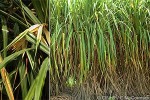Cook Islands Biodiversity Database
Species Page
Pandanus QQYulu
Yulu (PK)Sail Pandanus
Multimedia & Additional Resources
| Type | Description | Download |
| Plant and male flower (1) | 92KB | |
| Plant and male flower (2) | 91KB |
General Information
Cook Islands Distribution
| Southern Group: - Makatea: | ||||||||
RR |
MG |
AT |
MK |
MT |
AK |
PL |
TK |
MN |
- |
- |
- |
- |
- |
- |
|||
| Northern Group: Present | |||||
TN |
MH |
RK |
PK |
NS |
SW |
- |
- |
- |
++ |
- |
|
Scientific Taxonomy
Pandanus QQYulu
Query: male only plants on Pukapuka
TAXONOMY: PLANTAE; ANTHOPHYTA (=Angiospermae); LILIOPSIDA (=Monocotyledones); ARECIDAE; Pandanales; PANDANACEAE
More Information
GENERAL NOTE: Anne Chambers (USA) did anthropological research on Nanumea Atoll, Tuvalu, 1973-4. She reported (pers.comm. to K.Salisbury Oct/2004) on a Pandanus known locally as Hulu that was to about 3m, sprawling, with short branches, very old trees sometimes having male flowers (higano), propagated with cuttings, and leaves esteemed for making fine mats (epa), and wood not used for building because there is no main trunk. Nanumeans classed is a "kind of fala (pandanus)" but in a different category. St John identified her Hulu specimens (in BPBM) as Pandanus pulposus, and he identified several other specimens from tall-trunked, fruit-bearing fala vao as the same species. And it should also be noted that Pandanus pulposus (Warb.) Martelli is known from Palmyra (Line Islands) where its fruit has wedge-shaped drupes to 75x50mm. Kevin Salisbury reports (pers.comm. June/2004) that on Nukunonu, Tokelau, Kie was a type of pandanus that produced no fruit but its leaves (laukie) were particularly strong and durable and used to make fine mats. Apparently the dried leaves of the kie were known as hulu. In Pukapuka Yulu, a cognate of hulu has leaves known as laukie that are durable and esteemed for fine mats, and the tree has male flowers only. It seems likely that these three pandanus that do not develop fruit, that are esteemed for fine mats are the same species of pandanus. If St John is correct in identifying it as Pandanus pulposus, a species also known to have fruit, then it must a mutant male form of the species. Further study of specimens is required to resolve this issue. In the meantime the Pukapuka plants are maintained here under the name Pandanus QQYulu. [G.McC. 12/2004]
Vouchers & References
Vouchers:
Pukapuka: fieldspecimen+photo, 2/2004, G.McCormack with ID as Pandanus QQYulu.
References:
None recorded.
Data Update History (information):
zTX, zB02, zM05a
Web Resources
Citation Information
McCormack, Gerald (2007) Cook Islands Biodiversity Database, Version 2007.2. Cook Islands Natural Heritage Trust, Rarotonga. Online at http://cookislands.bishopmuseum.org. ![]()
Please refer to our use policy.

